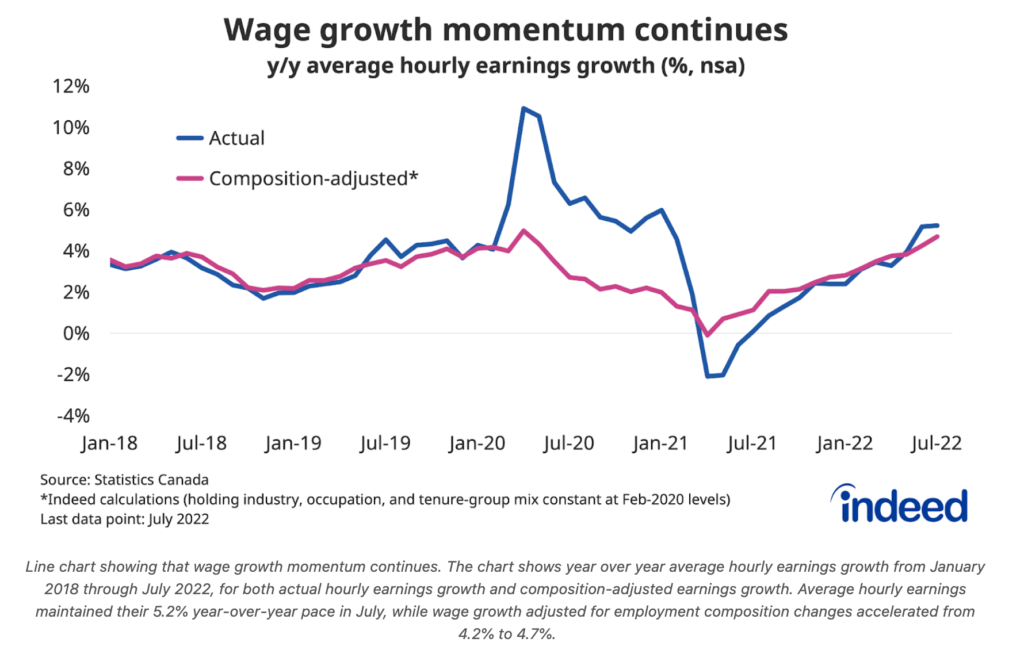Key points
- Total Canadian job postings on Indeed have slipped 8% from their early May peak, but were still up 60% compared to their pre-pandemic level on August 26, 2022.
- New job postings have cooled from earlier in the year, but continue to be added at a solid pace, suggesting easing of hiring appetite in the face of increased economic uncertainty, rather than an abrupt shift in sentiment.
- Job postings in areas like tech, loading and stocking, and human resources have declined faster than average in recent weeks, but from exceptionally high levels. Meanwhile, job postings in health care and education have held up better than the economy-wide trend.
As of August 26th, total Canadian job postings on Indeed were up 60% from their February 1, 2020 levels, after adjusting for seasonal trends. Postings have gradually declined this summer, totalling an 8% drop from their early-May peak. However, since they topped-out so high, their current overall level remains elevated.
The softening in total postings partly reflects new postings being added at a cooler pace. The number of new Canadian job postings on Indeed (seven days old or less) on August 26th was up 49% from their pre-pandemic rate, down even more from May levels than total postings. However, despite the downshift, new postings continue to be added similarly to their solid pace in October 2021. As a result, while the boom is fading, overall hiring appetite hasn’t shown an abrupt shift in sentiment.
Postings have slipped across provinces
The dip in job postings at the national level also shows up across provinces, with all regions edging down by at least 2% since the start of May. Postings in the Prairies and Atlantic Canada remain further above their pre-pandemic levels than Quebec and B.C., likely reflecting the fact that these latter provinces entered the crisis with already elevated job vacancy rates.
Some high-flying sectors have cooled more than the headline trend
Canadian job postings are elevated, but have slipped in most sectors. Some of the areas to see the steepest declines are fields where postings had previously soared beyond pre-pandemic levels by even more than the economy-wide trend, and still remain quite elevated. For instance, postings in software development and loading and stocking are currently 88% and 93% above pre-pandemic levels, respectively, but both are down noticeably from peaks of 127% reached this spring. Human resources job postings have also followed a similar trend, consistent with a broader softening of employer hiring appetite.
Goods producing sectors relatively stable after an earlier decline
Job postings in goods producing sectors like construction, production and manufacturing, and installation and maintenance have also retreated from early May. That said, after falling faster than the rest of the economy through mid-June, they’ve been fairly flat more recently. Given the historic cyclicality of these industries, it will be important to monitor for signs of further weakness, but so far postings remain elevated.
Health care and education following different patterns of late
Finally, while postings are down somewhat among most job types, some areas have been fairly stable, or even up, since the start of the summer. One of those sectors is health care, where nursing job postings have ticked up recently after cooling to start the year, now standing 83% above their pre-pandemic levels. Job postings have also been fairly stable in personal care and home health. Meanwhile postings in education and instruction have trended up this year, though they remain closer to pre-pandemic levels than economy-wide postings. In general, hiring appetite in public sector-related areas like health care and education is likely to be less cyclically sensitive than other industries, where macroeconomic uncertainty is especially relevant.
Methodology
All job postings figures in this blogpost are the percentage change in seasonally-adjusted job postings since February 1, 2020, using a seven-day trailing average. February 1, 2020, is our pre-pandemic baseline. We seasonally adjust each series based on historical patterns in 2017, 2018, and 2019. Each series, including the national trend, occupational sectors, and sub-national geographies, is seasonally adjusted separately. This week we applied our quarterly revision, which updates seasonal factors and fixes data anomalies. Historical numbers have been revised and may differ from originally reported values. New job postings are posts that are 7-days old or less.
The number of job postings on Indeed, whether related to paid or unpaid job solicitations, is not indicative of potential revenue or earnings of Indeed, which comprises a significant percentage of the HR Technology segment of its parent company, Recruit Holdings Co., Ltd. Job posting numbers are provided for information purposes only and should not be viewed as an indicator of performance of Indeed or Recruit. Please refer to the Recruit Holdings investor relations website and regulatory filings in Japan for more detailed information on revenue generation by Recruit’s HR Technology segment.



